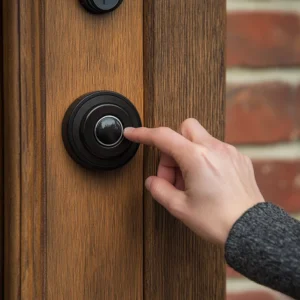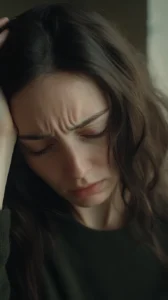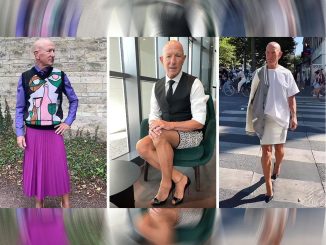Kevin had already made his Halloween costume with his mom and helped his dad decorate their house. He was excited about how much candy he would collect. But one house on his street didn’t have any decorations, and that kept bothering him. He didn’t understand why someone wouldn’t celebrate Halloween, so he thought maybe they needed help.
Halloween was almost here, and the entire neighborhood was buzzing with excitement. Every yard seemed to be trying to be the scariest one around.
There were pumpkins with big, jagged smiles all along the sidewalks. Plastic skeletons hung from tree branches, and fake cobwebs covered porches.
The air smelled like dry leaves and candy, and eleven-year-old Kevin could feel his heart racing with excitement.

Halloween was Kevin’s favorite day of the year, a time when anyone could be whatever they wanted. He loved how everything changed for that one magical night.

As he walked down the street, he smiled, looking at the glowing jack-o’-lanterns and spooky ghosts decorating the houses. Some homes even played creepy sounds like witches’ laughter and creaking doors.

But something different caught his eye as he went farther down the street. One house was dark and plain, with no decorations at all. It was Mrs. Kimbly’s house.

Mrs. Kimbly was an older woman who lived alone. Kevin had helped her before, mowing her lawn in summer and shoveling snow in winter, but she rarely said much. Her undecorated house seemed out of place in the festive neighborhood.

Kevin felt bad that her house had no Halloween spirit. He thought maybe she needed help with the decorations. Determined, he crossed the street and knocked on her door.

When Mrs. Kimbly answered, her face showed annoyance. “What do you want, Kevin?” she asked in a gruff voice.

“I noticed you don’t have any Halloween decorations. I could help you put some up, if you’d like,” Kevin offered.

Mrs. Kimbly frowned. “I don’t need decorations, and I don’t need help,” she said sharply before slamming the door.

Kevin was surprised. How could anyone hate Halloween so much? He didn’t want her house to be a target for pranks, like kids throwing toilet paper, so he came up with a plan.

At home, Kevin told his mom, Sarah, about Mrs. Kimbly’s undecorated house and how she had slammed the door in his face. His mom suggested leaving her alone, explaining that people might have reasons for not celebrating.

But Kevin didn’t think Mrs. Kimbly hated Halloween—she seemed lonely. So, he decided to help anyway.

He gathered all the Halloween decorations he could find, including his favorite pumpkin, and hurried back to Mrs. Kimbly’s house. He carefully hung lights and placed pumpkins on her porch. As he finished, the front door opened, and Mrs. Kimbly stormed out, furious.

“I told you not to decorate my house!” she yelled. She grabbed Kevin’s carved pumpkin and smashed it on the ground. Kevin was shocked and hurt, but he whispered, “I just wanted to help,” before running home.

That night, Kevin put on his vampire costume, but he couldn’t enjoy Halloween. He was worried about Mrs. Kimbly’s house being pranked. So, he returned to her house and sat on her porch, handing out candy from his own bag to trick-or-treaters, explaining that Mrs. Kimbly wasn’t home.

As he sat alone, the door creaked open. Mrs. Kimbly stepped out, her expression softer this time.
“What are you doing here, Kevin?” she asked quietly.
“I didn’t want anyone to mess with your house,” Kevin explained. “I thought I could help.”
Mrs. Kimbly sighed and sat beside him. She admitted that Halloween was hard for her because it reminded her of how alone she was. She had no family to share it with.
Kevin understood now. “You don’t have to be alone,” he said. “You can celebrate with the rest of us.”

Mrs. Kimbly smiled sadly and thanked Kevin for his kindness. She even apologized for smashing his pumpkin. Kevin promised to bring another one so they could carve it together.
For the first time in years, Mrs. Kimbly felt the warmth of Halloween again, thanks to the caring heart of one determined boy.
My Friend Didn’t Believe Her Husband Was Cheating, So I Set Up a Scene to Prove It

When her best friend refused to believe her husband was cheating on her, Nancy was determined to open her eyes. She set up a foolproof trap, but as the plan unfolded, Nancy was unprepared for the explosive consequences.
Alright everyone, Nancy here. Ever had that friend, the one who wears rose-colored glasses thicker than a disco ball? Yeah, that’s Melissa. Now, Melissa’s husband, Victor, is the epitome of a wolf in sheep’s clothing. Picture perfect husband on the outside, but on the inside… well, let’s just say his loyalty roams free like a stray dog…

For the past year, whispers about Victor’s little “extracurricular activities” had been swirling around town like tumbleweeds in a dusty desert.
Pub crawls with “mystery women,” extra-long “work nights” that ended way too close to sunrise at that sketchy karaoke bar on Elm Street — the signs were all there, neon bright.
But Melissa? Bless her heart, she clung to the fantasy of their “perfect” marriage like a life raft in a hurricane.
At first, it was kind of cute. You know, the “ignorance is bliss” kind of thing.
But seeing Melissa walk on eggshells around Victor, making excuses for his shady behavior, it started to grate on me. The girl was practically begging to get her heart broken!
Enough was enough.

One gloomy Tuesday evening, armed with a bottle of the strongest wine I could find and a heart full of frustration, I marched over to Melissa’s house. You know that feeling when you just gotta lay it all out, consequences be damned? That’s exactly where I was at.
Melissa opened the door with a bright smile that faltered the second she saw my stormy expression.
“Hey Nancy,” she said. “What brings you here?”
I pushed past her, the wine bottle threatening to topple over in my trembling hand. “We need to talk,” I declared.
Melissa’s smile vanished completely, replaced by a flicker of worry. We settled down on the couch, and I launched into my spiel, laying out all the rumors, the suspicious disappearances, the way Victor’s eyes lingered a little too long on other women.
But Melissa wouldn’t budge and tears welled up in her eyes. “You’re being ridiculous, Nancy,” she sniffled. “Victor would never do anything like that. He loves me.”
My frustration bubbled over. “Loves you?!” I practically shouted. “Love doesn’t involve sneaking around and hiding phone calls! Melissa, wake up and smell the coffee — or maybe the cheap perfume clinging to his clothes!”
That was the final straw. Melissa’s face hardened, her eyes blazing with hurt and anger. “This is my marriage, Nancy,” she snapped. “If you can’t be supportive, then maybe you should leave.”
My heart sank.

I hadn’t meant to drive a wedge between them, just to open her eyes. But clearly, logic wasn’t winning this battle.
Defeated, I grabbed my abandoned wine and shuffled out, the slam of the door echoing my failure in my ears.
Sitting alone in my apartment, I knew I couldn’t just leave Melissa like that, living in a fool’s paradise. But how could I break through the wall she’d built around her perfect little world?
An idea, crazy and impulsive, sparked in my mind. Maybe I could give Melissa the undeniable PROOF she needed.
With a deep breath, I grabbed my phone and dialed Victor’s number. The phone rang for what felt like an eternity before a smooth, familiar voice answered.
“Hey Nancy, this is unexpected,” Victor said, a hint of surprise lacing his tone.

Ugh, the nerve of this guy! I steeled myself, channeling my anger into a voice dripping with feigned flirtation.
“Hey Victor,” I purred, “Guess what? I got promoted! To celebrate, I’m thinking of having a little ‘get-together’ with a special friend this weekend. And guess who immediately popped into my head?”
Silence. I held my breath, willing him to take the bait.
“Well?” I pressed, trying to sound nonchalant. “Are you coming…?”
Then, a low chuckle traveled through the phone. My stomach clenched. “Well, Nancy,” Victor said, his voice smooth as silk, “I’m always up for a good time. Tell me more…”
The sound of Victor’s chuckle sent a shiver down my spine, a mix of disgust and a surge of morbid satisfaction. He’d taken the bait. Now came the tricky part.
“Actually,” I interjected, trying to sound casual, “I was thinking of something a little more… discreet.” I could practically hear the question marks forming in his head. Perfect.
“Discreet, huh?” he repeated, his voice laced with a hint of intrigue. “What did you have in mind?”
I took a deep breath. This was it. “There’s this new upscale pub downtown,” I said, dropping the name of the very same pub he frequented with his “other women.” “Heard it’s got a private room, perfect for a little… celebration.”
A beat of silence followed. Then, a low whistle came through the phone. “Now that’s interesting, Nancy,” Victor said, his voice a touch huskier. “Are you sure about this? You know, Melissa…”
“Don’t worry about Melissa,” I cut him off. “She won’t know a thing… I promise. It’ll be just you and me.”
There was another pause, longer this time. My heart pounded in my chest. Was he suspicious? Had I blown the whole operation?
Finally, Victor spoke. “Alright, Nancy,” he purred. “You’ve convinced me. Just tell me what time, and I’ll be there… in your arms, darling.”
Relief washed over me so strong I almost dropped the phone. He’d agreed! My gamble had paid off. “Great!” I said, forcing a light tone. “I’ll text you the details later. Just make sure you come alone, okay?”
“Wouldn’t dream of it,” Victor chuckled. “See you then, babe.”

With that, the line went dead. I stared at the phone, elation and dread bubbling in my stomach. I’d set the trap, but now what? Would Melissa actually believe me? More importantly, would she be strong enough to face the truth, however ugly it might be?
With a mischievous grin, I fired off a text to Melissa, apologizing profusely for my outburst the other night.
“Ugh, Nancy,” she replied, her message dripping with annoyance. “Can we talk about this later? I’m swamped right now.”
I wasn’t about to give up. I bombarded her with messages, each one brimming with fake remorse and a desperate plea to meet for drinks.
“Come on, Mel,” I texted, “Let’s just grab a quick drink and clear the air. My treat! This Saturday. Please.”
Finally, on Friday afternoon, I received a one-word reply: “Fine.”
Victory! Saturday arrived. Today was the day I’d expose Victor for the lying, cheating weasel he was. I spent hours primping, slipping into the most elegant dress I could find.
Walking into the upscale pub, I felt completely out of my comfort zone.
As promised, Victor was already there, perched at the bar, nursing a drink on the rocks. His eyes lit up when he saw me.
“Nancy,” he exclaimed, a smooth smile gracing his lips, “you look absolutely… like a goddess.”

I plastered on a sheepish grin. “Thanks, Victor,” I purred, forcing down the wave of disgust rising in my throat. “Mind if I join you?”
He gestured to the empty stool beside him. We settled in, making awkward small talk as the bartender mixed me a drink. Victor kept stealing glances at me, a flicker of suspicion replacing his initial amusement.
“So,” he finally started, his voice laced with curiosity, “what’s with the sudden change of heart, Nancy? You’re usually not one for crowded bars or… well… me.”
Busted. I cleared my throat, mentally scrambling for a convincing story.
“Honestly, Victor,” I confessed, batting my eyelashes for effect, “I’ve been kicking myself ever since the dinner the other night. You were so kind, so attentive… it awakened something in me.”
Victor’s eyebrows shot up. This was it. Time to reel him in.
I leaned closer, “Maybe,” I said, my cheeks burning with shame, “I was a little afraid to act on my feelings before. But hey, life’s too short, right?”
A slow smile spread across Victor’s face. He scanned me from head to toe, his gaze lingering a little too long on certain curves. I felt a wave of nausea roll through me, but I pushed it down. This was all for Melissa.
Suddenly, my phone buzzed in my purse. A text from Melissa. My heart raced. “On my way,” it read

I quickly typed out a one-line reply: “Come straight to the bar.” Sliding my phone back into my purse, I took a deep breath.
Just then, the pub door swung open and Melissa walked in.
My cue. I threw my arms around Victor’s neck and leaned in for a kiss. “Kiss me, you fool!” I whispered dramatically.
Victor, clearly flustered, hesitated for a split second before returning the kiss. It was a clumsy, awkward peck, but it was enough. I pulled back, a triumphant smile lighting up my face..

“See, Melissa?” I declared, turning towards my friend.
“This is what I’ve been talking about! Your husband’s a complete jerk!”
The smile vanished from Melissa’s face, replaced by a mask of shock and sheer disbelief. Victor, however, sputtered to his feet, his face flushed crimson.
“Melissa, honey,” he stammered, “it’s not what it looks like! She’s the one who—”
“Don’t even try to lie your way out of this, Victor!” I cut him off, relishing the momentary power shift. “The jig is up!”
But before I could launch into a full-blown exposé, Victor whipped out his phone. A sickening feeling of dread crept into my stomach. He pressed a button, and a voice filled the air — my voice. Crystal clear, unmistakable.
“Hey Victor,” the voice purred, “guess what? I got promoted! To celebrate, I’m thinking of having a little ‘get-together’ with a special friend this weekend. And guess who immediately popped into my head?”
My blood ran cold.
The voice on the phone was mine, the exact words I’d used to set the trap. Victor had recorded our conversation. I was caught, my elaborate plan backfiring spectacularly.
“See, honey,” Victor finished, his voice dripping with false sincerity, “I told you she was the one coming on to me. I’m innocent. I just came here for a drink. It was all her.”
Melissa’s face contorted with anger and confusion. She looked between me and Victor, her gaze lingering on the phone in his hand. The silence stretched on, thick and suffocating.
“NANCY,” Melissa yelled, “is this… TRUE??”
My throat constricted. I wanted to scream, to explain, but the words wouldn’t come.
The weight of my actions pressed down on me, heavy and suffocating. Shame burned in my cheeks, hotter than any cocktail I’d ever tasted.
“I…” I stammered. “I just… I wanted you to see—”
“See what?” Melissa cut me off, her voice rising.
“See you ruin my marriage with your lies and accusations? You almost made me throw away the best thing that ever happened to me, all on the basis of some twisted suspicion!”
Tears welled up in her eyes. “You call yourself my best friend? This is how you treat me?”

I opened my mouth to apologize, but the words died in my throat. Melissa was right. My misguided attempt at helping had backfired spectacularly. I’d hurt her, betrayed her trust, and all for nothing.
Victor, sensing his advantage, placed a comforting hand on Melissa’s shoulder. “There, there, honey,” he murmured. “Don’t listen to her. She’s clearly jealous of what we have.”
Melissa shot him a watery smile, leaning into his touch. My stomach churned. Had I been so blinded by my suspicion that I’d missed the genuine affection between them? Or was Victor that good of an actor?
“Get out of my life, Nancy,” Melissa yelled. “And don’t you ever contact me again.”
There was no denying the finality in her voice. Tears streamed down my face as I watched Melissa stumble out of the bar with Victor in tow.
A week had passed since that fateful night. The silence from Melissa was deafening. My calls went unanswered, my texts left on read. Social media confirmed my worst fear — I was blocked.
Sitting alone in my apartment, replaying the scene over and over in my head, I felt a wave of self-loathing wash over me. I’d messed up, royally.
So, am I wrong? The answer, unfortunately, is clear. Yes. Yes, I was wrong. Dead wrong.
My intentions, while misguided, may have stemmed from a place of care. But the way I went about it? A complete disaster.
You know, I get it. Looking back, my whole plan to expose Victor was a dumpster fire wrapped in a trainwreck. But honestly, do you think I was the villain here? Sure, I messed up, big time. But Melissa deserved to know the truth, right? Or was I way out of line for meddling? Hit me with your thoughts.




Leave a Reply